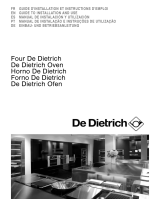english
You can set your choux and puff pastries, meringues,
madeleines and other delights directly on it.
N.B.: The baking sheet should never be used to hold baking
dishes or cake moulds.
• Multi-purpose 20 mm dish (2.2.3)
• Multi-purpose 45 mm dish (2.2.4)
When inserted in the supports under the grid, it collects juice
and fat from grilling, and can be used half-filled with water
as a double-boiler.
• 45 mm multi-purpose tray. Fully accessible sliding rail
system (2.2.5)
The new sliding rail system with support (fully accessible)
makes food more practical and easier to handle as the trays
can be effortlessly pulled for simpler handling. The trays can
be completely removed, providing full access (2.2.6).
Their stability ensures that food can be handled safely,
reducing the risk of burns. This means that you can take
food out of the oven far more easily (2.2.7).
The drip tray in the bottom of the oven collects juice and fat
from grilling, and can be used half-filled with water as a
double-boiler. Do not directly place meat or poultry on the
drip tray for roasting. This would inevitably produce splashes
and dirty the sides of the oven.
• 45 mm deep dish with a support grid for grilling (2.2.8)
This is used to collect cooking juices from meat or fish
placed directly on its grill in grill or pulsed grill sequence.
Never place this dish on the oven floor (risk of damage to the
enamel) except in grill position (the oven floor heating
element does not operate in these positions).
• Dish extracting support (2.2.9)
Thanks to this system, you can slide out your enamelled dish
all the way and easily access your preparations during
cooking.
Remove from the oven before starting pyrolytic
cleaning.
• Rotisserie
To use it:
- place the standard tray in the bottom shelf supports to
collect the cooking juices (or on the oven floor, if the joint to
be roasted is too large).
- thread one of the forks on to the spit, then skewer the joint,
thread on the second fork, centre the joint and screw the two
forks tight (2.2.11).
- place the spit on its cradle and push gently to engage the
tip of the spit in the square drive at the back of the oven
(2.2.12).
- pull out the handle with an unscrewing motion, so as to
allow the door to close (2.2.13). When cooking is finished,
screw on the spit handle once again, so that you can remove
the joint without burning yourself.
CHILD SAFETY (depending on model)
Activating the child safety lock (2.3.1):
Open the door. On the left under the control panel there is a
plastic lever (A) (sat between two lugs). Lower this part until
there is a click.
Safety is now activated. Close the door again.
Opening the door while keeping child safety lock active:
Push the tongue (B) to the right, hold it there and pull on the
door at the same time to open it.
De-activating the child safety look:
Open the door. Push the tongue (B) to the right, until there is
a click.
Warning:
Before starting a pyrolysis cleaning cycle, make sure
that any accessories that are not pyrolysis safe have
been removed from the oven (sliding rails, baking trays,
chrome-plated grills, and so on) as well as any
cookware. The side grills are pyrolysis safe and may be
left inside the oven during pyrolysis.
















